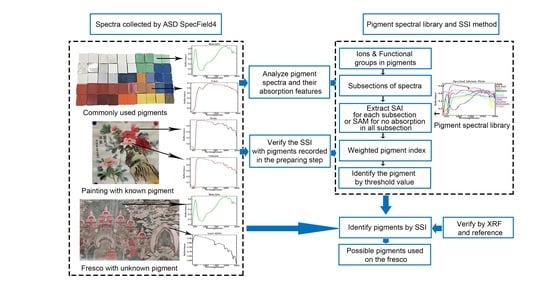A Novel Spectral Matching Approach for Pigment: Spectral Subsection Identification Considering Ion Absorption Characteristics
Abstract
1. Introduction
2. Materials and Methods
2.1. SSI Method
- (1)
- Perform the continuum removal on the unknown spectrum and the standard spectra in pigment spectral library.
- (2)
- Determine the number of subsections for the unknown spectrum as sub_int. The five detection ranges should be checked one by one to select the characteristic subsection(s), where the unknown spectrum has significant absorption characteristics as sub_int = (sub_int1, sub_int2, … sub_intm) (m is the number of subsections, 0 < m ≤ 5), for subsequent spectral subsection identification.
- (3)
- If the unknown spectrum does not have any characteristic subsection, the whole spectrum will be used for traditional identification. Then, go to step (9).
- (4)
- Judge whether there is a single absorption feature in each subsection. If it is false, then go to step (6).
- (5)
- If there is a single absorption feature in the subsection, the similarities between spectra will be calculated by using SAI. Firstly, the SAI is calculated within the subsection of the unknown spectrum and all standard spectra in the pigment spectral library as SAI_u and SAI_s = (SAI_s1, SAI_s2, … SAI_sn). Secondly, the difference is calculated between each element in SAI_si and the SAI_u. Finally, the smaller the absolute value result of (SAI_si-SAI_u), the higher is the similarity between the corresponding standard spectrum and the unknown spectrum in this subsection. The top three results with the highest similarity in each subsection will be selected. Then, go to step (7).
- (6)
- If there is no single absorption feature in the subsection, the similarities between spectra will be calculated by SAM. Firstly, the standard spectra within the subsection are extracted from pigment spectral library (after continuum removal). Then, we calculate the cosine of the spectral angles between them and the unknown spectrum in corresponding subsection. The larger the cosine value of the spectral angle, the higher is the similarity between the corresponding standard spectrum and the unknown spectrum in this subsection. The top three results with the highest similarity in each subsection will be selected.
- (7)
- Assign the weights. The top three pigments obtained in each subsection by step (5) or (6) are assigned weights of 3/3m, 2/3m, and 1/3m in order of ranking, respectively, where m is the number of subsections of the entire spectrum, and 0 < m ≤ 5. It should be noted that the higher ranking indicates that the pigment has a higher similarity with the unknown spectrum in this subsection. Therefore, the larger fraction will be assigned to the pigment. However, the pigment with the largest fraction in one subsection cannot be directly considered to exist in the mixed area, because the final identification result needs to be obtained by accumulating the weight scores of all the subsections.
- (8)
- Calculate the corresponding weighted index of each result according to the weights. According to the resulting weights of each characteristic subsection, the weighted index of each result is calculated. In that way, the existence of each pigment in mixture can be represented by the percentage. Moreover, the weighted index of pigment indicates the possibility of existence of the pigment, although it is not a strictly statistical probability.
- (9)
- To obtain the final identification result.
2.2. Spectral Library Establishment
2.2.1. Samples of Spectral Library
Pigment Selection
Glue Preparation
Sample Design
2.2.2. The Instruments for Data Collection
2.2.3. The Typical Pigment Spectral Library
2.3. Typical Ion Absorption Positions of Pigments
2.4. SAI and SAM
3. Experiments and Results
3.1. Experiment of a Chinese Painting
3.1.1. Data Collection of the Chinese Painting
3.1.2. Pigment Identification of the Chinese Painting Using Two Methods
3.1.3. Comparison of the Identification between the Two Methods in the Chinese Painting
- ①
- C1 was painted with pigments of eosin, crimson, and madder according to the record. The eosin and crimson were identified correctly both by SSI and traditional one, while the pigment madder was missed by the approach proposed.
- ②
- C2 was painted with pigments of crimson and clam meal. Both SSI and the traditional method correctly identified the crimson, but neither identified the clam white.
- ③
- C3 was painted with pigments of malachite and ink, which were correctly identified by using traditional method, while the ink was missed by using SSI method.
- ④
- C4 was painted with pigments of ocher and malachite. The pigments contained in the region were correctly identified by using the SSI method, but the ocher was missed by the traditional one.
- ⑤
- C5 was painted with pigments of malachite and ocher, which are correctly identified by using SSI method, while the ocher was missed by using the traditional method.
3.2. Experiment of a Fresco
3.2.1. Data Collection of the Fresco
3.2.2. Pigment Identification of Fresco Using Two Methods
3.2.3. Comparison of Identification between Two Methods in the Fresco
- ①
- F1 may have the Cu and Ca element according to the XRF results. Both SSI and the traditional method correctly identified pigments containing these two elements.
- ②
- F2 may have three elements, including the S, Hg, and Ca elements, according to XRF results. The SSI method correctly identified all of these elements, while the Ca was missed by using the tradition method.
- ③
- F3 may have the mixed pigments containing S, Cu, and Pb. Both of the two methods correctly identified the pigments containing Cu, but missed the other two elements.
- ④
- F4 may have four kinds of elements, including S, Pb, Ca, and Cu. The SSI method correctly identified three of them but missed the Cu in the final result. Only one kind of pigment containing the S element was identified by the traditional method.
- ⑤
- F5 may be a mixture containing the S, Pb, and Ca elements according to XRF results. Both SSI and the traditional method correctly identified pigments containing the Pb and Ca. While they missed the S in the final result.
4. Discussion
- (1)
- By using the SSI method, the correct rate of the first result in the five regions is 100.0%, and of the top three results 73.4%. Combined with the results of Chinese painting in Table 7, this method has limited ability to identify white and black pigments. Nevertheless, the first result obtained by this method is reliable, and the top three results can correctly identify the main components in the mixed area on the surface of Chinese painting.
- (2)
- Through applying the traditional method, the correct rate of the first result is 80.0%, and of the top three results 70.0%, which are lower than for the SSI method. Moreover, combined with the results presented in Table 7, the traditional method missed the ocher and white pigments in each mixed area.
- (1)
- (2)
- By using the traditional method, the correct rate of the first result is 60.0%, and of the top three results 58.4%. It can be seen that the accuracy of the traditional method is also lower than that of the SSI method, even for the fresco.
5. Conclusions
Author Contributions
Funding
Acknowledgments
Conflicts of Interest
References
- Platania, E.; Streeton, N.L.; Lluverastenorio, A.; Vila, A.; Buti, D.; Caruso, F.; Kutzke, H.; Karlsson, A.; Colombini, M.P.; Uggerud, E. Identification of green pigments and binders in late medieval painted wings from Norwegian churches. Microchem. J. 2020, 156, 104811. [Google Scholar] [CrossRef]
- Berrie, B.H.; Leona, M.; Mclaughlin, R. Unusual pigments found in a painting by Giotto (c. 1266–1337) reveal diversity of materials used by medieval artists. Herit. Sci. 2016, 4, 1. [Google Scholar] [CrossRef]
- Fanost, A.; Gimat, A.; de Viguerie, L.; Martinetto, P.; Giot, A.C.; Clémancey, M.; Blondin, G.; Gaslain, F.; Glanville, H.; Walter, P.; et al. Revisiting the identification of commercial and historical green earth pigments. Colloids Surf A Physicochem. Eng. Asp. 2020, 584, 124035. [Google Scholar] [CrossRef]
- Miliani, C.; Rosi, F.; Burnstock, A.; Brunetti, B.G.; Sgamellotti, A. Non-invasive in-situ investigations versus micro-sampling: A comparative study on a Renoirs painting. Appl. Phys. 2007, 89, 849–856. [Google Scholar] [CrossRef]
- Bacci, M.; Fabbri, M.; Picollo, M.; Porcinai, S. Non-invasive fibre optic Fourier transform-infrared reflectance spectroscopy on painted layers: Identification of materials by means of principal component analysis and Mahalanobis distance. Anal. Chim. Acta 2001, 446, 15–21. [Google Scholar] [CrossRef]
- Casadio, F.; Leona, M.; Lombardi, J.R.; van Duyne, R. Identification of organic colorants in fibers, paints, and glazes by surface enhanced Raman spectroscopy. Acc. Chem. Res. 2010, 43, 782–791. [Google Scholar] [CrossRef]
- Bacci, M. Fibre optics applications to works of art. Sens. Actuators 1995, 29, 190–196. [Google Scholar] [CrossRef]
- Camaiti, M.; Benvenuti, M.; Costagliola, P.; di Benedetto, F.; del Ventisette, C.; Garfagnoli, F.; Lombardi, L.; Moretti, S.; Pecchioni, E.; Vettori, S. Monitoring of chemical and physical characteristics of stone surfaces by a portable spectroradiometer. EGU Gen. Assem. 2013, 15, 13552. [Google Scholar]
- Wang, L.; Dang, G.; Zhao, J. Nondestructive analysis and identification of pigments on colored relics by fiber optic reflectance spectroscopy. Spectrosc. Spectr. Anal. 2008, 28, 1722–1725. (In Chinese) [Google Scholar]
- Colombo, C.; Bevilacqua, F.; Brambilla, L.; Conti, C.; Realini, M.; Striova, J.; Zerbi, G. Terracotta polychrome sculptures examined before and after their conservation work: Contributions from non-invasive in situ analytical techniques. Anal. Bioanal. Chem. 2011, 401, 757–765. [Google Scholar] [CrossRef]
- Thoury, M.; Delaney, J.K.; de la Rie, E.R.; Palmer, M.; Morales, K.; Krueger, J. Near-infrared luminescence of cadmium pigments: In situ identification and mapping in paintings. Appl. Spectrosc. 2011, 65, 939–951. [Google Scholar] [CrossRef] [PubMed]
- Cheilakou, E.; Troullinos, M.; Koui, M. Identification of pigments on Byzantine wall paintings from Crete (14th century AD) using non-invasive fiber optics diffuse reflectance spectroscopy (FORS). J. Archaeol. Sci. 2014, 41, 541–555. [Google Scholar] [CrossRef]
- Cucci, C.; Bartolozzi, G.; De Vita, M.; Marchiafava, V.; Picollo, M.; Casadio, F. The colors of Keith Haring: A spectroscopic study on the materials of the mural painting Tuttomondo and on reference contemporary outdoor paints. Appl. Spectrosc. 2016, 70, 186. [Google Scholar] [CrossRef] [PubMed]
- Yang, L.; Huang, J.; Chen, X.; Lyu, H.; Wang, L.; Su, B. Nondestructive analysis of culture relics pigments by chemometrics combined with diffuse reflectance spectroscopy. J. Instrum. Anal. 2020, 39, 844–850. (In Chinese) [Google Scholar]
- Wan, Y. The analysis of mineral and rock’s hyper-spectral library. Geo Inf. Sci. 2001, 3, 54–58. (In Chinese) [Google Scholar]
- Kokaly, R.F.; Clark, R.N.; Swayze, G.A.; Livo, K.E.; Hoefen, T.M.; Pearson, N.C.; Wise, R.A.; Benzel, W.M.; Lowers, H.A.; Driscoll, R.L.; et al. USGS Spectral Library Version 7; US Geological Survey: Reston, VA, USA, 2017.
- Grove, C.I.; Hook, S.J.; Paylor, E.D., III. Laboratory Reflectance Spectra of 160 Minerals, 0.4 to 2.5 Micrometers; Jet Propulsion Laboratory: Pasadena, CA, USA, 1992.
- Pal, S.; Majumdar, T.; Bhattacharya, A.K.; Bhattacharyya, R. Utilization of Landsat ETM+ data for mineral-occurrences mapping over Dalma and Dhanjori, Jharkhand, India: An advanced spectral analysis approach. Int. J. Remote Sens. 2011, 32, 4023–4040. [Google Scholar] [CrossRef]
- Tian, Z.; Liu, S.; Fu, Y. Design and realization of spectral data management in the spectral knowledge base. IEEE Int. Geosci.Remote Sens. Symp. 2004, 7, 4410–4413. [Google Scholar]
- Baldridge, A.M.; Hook, S.; Grove, C.; Rivera, G. The ASTER spectral library version 2.0. Remote Sens. Environ. 2009, 113, 711–715. [Google Scholar] [CrossRef]
- Cosentino, A. FORS spectral database of historical pigments in different binders. E-Conserv. J. 2014, 2, 57–68. [Google Scholar] [CrossRef]
- Balas, C.; Epitropou, G.; Tsapras, A.; Hadjinicolaou, N. Hyperspectral imaging and spectral classification for pigment identification and mapping in paintings by El Greco and his workshop. Multimed. Tools Appl. 2018, 77, 1–15. [Google Scholar] [CrossRef]
- Bayarri, V.; Sebastián, M.A.; Ripoll, S. Hyperspectral imaging techniques for the study, conservation and management of rock art. Appl. Sci. 2019, 9, 5011. [Google Scholar] [CrossRef]
- Wu, T.; Li, G.; Yang, Z.; Zhang, H.; Lei, Y.; Wang, N.; Zhang, L. Shortwave infrared imaging spectroscopy for analysis of ancient paintings. Appl. Spectrosc. 2017, 71, 977. [Google Scholar] [CrossRef]
- Dupuis, G.; Elias, M.; Simonot, L. Pigment identification by fiber-optics diffuse reflectance spectroscopy. Appl. Spectrosc. 2002, 56, 1329–1336. [Google Scholar] [CrossRef]
- Shi, N.; Li, G.; Lei, E.; Wu, T. Hyperspectral imaging to Chinese paintings at the Palace Museum. Sci. Conserv. Archaeol. 2017, 29, 23–29. (In Chinese) [Google Scholar]
- Wang, W.; Wang, H.; Wang, K.; Wang, Z. An identification method of spectral information divergence pigment based on statistical manifold. Laser Optoelectron. Prog. 2018, 55, 416–423. (In Chinese) [Google Scholar]
- Zhang, J.; Rivard, B.; Sanchez-Azofeifa, A. Derivative spectral unmixing of hyperspectral data appied to mixtures of lichen and rock. IEEE Trans. Geosci. Remote Sens. 2004, 42, 1934–1940. [Google Scholar] [CrossRef]
- Demetriades-Shah, T.H.; Steven, M.D.; Clark, J.A. High resolution derivative spectra in remote sensing. Remote Sens. Environ. 1990, 33, 55–64. [Google Scholar] [CrossRef]
- Tsai, F.; Philpot, W.D. A derivative-aided hyperspectral image analysis system for land-cover classification. IEEE Trans. Geosci. Remote Sens. 2002, 40, 416–425. [Google Scholar] [CrossRef]
- Fonseca, B.; Patterson, C.S.; Ganio, M.; MacLennan, D.; Trentelman, K. Seeing red: Towards an improved protocol for the identification of madder and cochineal-based pigments by fiber optics reflectance spectroscopy (FORS). Herit. Sci. 2019, 7, 92. [Google Scholar] [CrossRef]
- Wu, F.; Yang, W.; Li, D. Research on art painting pigment composition recognition based on spectra feature fitting. J. Light Scatt. 2014, 26, 88–92. (In Chinese) [Google Scholar]
- Cen, Y.; Zhang, L.; Sun, X.; Zang, L.; Zhao, H.; Wang, X. Spectral analysis of main mineral pigments in Thangka. Spectrosc. Spectr. Anal. 2019, 39, 146–152. (In Chinese) [Google Scholar]
- Wang, K.; Wang, H.; Yin, Y.; Mao, L.; Zhang, Y. Pigment spectral matching recognition method based on adaptive edit distance. Laser Optoelectron. Progress 2018, 55, 487–494. (In Chinese) [Google Scholar]
- Zhang, L.; Wang, J.; Li, X.; Liu, S. A brief introduction to the standardized spectral database of typical ground objects. IEEE Int. Geosci. Remote Sens. Symp. 2004, 7, 4452–4455. [Google Scholar]
- Borsoi, R.A.; Imbiriba, T.; Bermudez, J.C.M.; Richard, C. Deep generative models for library augmentation in multiple endmember spectral mixture analysis. IEEE Geosci. Remote Sens. Lett. 2020, PP99, 1–5. [Google Scholar] [CrossRef]
- Fatemeh, F.; Saeideh, K. Identification of pigments in artworks by inverse tangent derivative of spectrum and a new filtering method. Herit. Sci. 2020. [Google Scholar] [CrossRef]
- Wang, J.; Zhang, L.; Liu, Q.; Zhang, B.; Yin, Q. Chinese Typical Spectrum Knowledge Base; Science Press: Beijing, China, 2009. (In Chinese) [Google Scholar]
- Wang, J.; Zheng, L.; Tong, Q. The spectral absorption identification model and mineral mapping by imaging spectrometer Data. Remote Sens. Environ. 1996, 11, 20–31. (In Chinese) [Google Scholar] [CrossRef]
- Wang, J.; Li, J.; Tang, J.; Xu, Z. Research on the murals pigments of Qutan Temple, Qinghai. Sci. Conserv. Archaeol. 1993, 5, 23–25. (In Chinese) [Google Scholar]
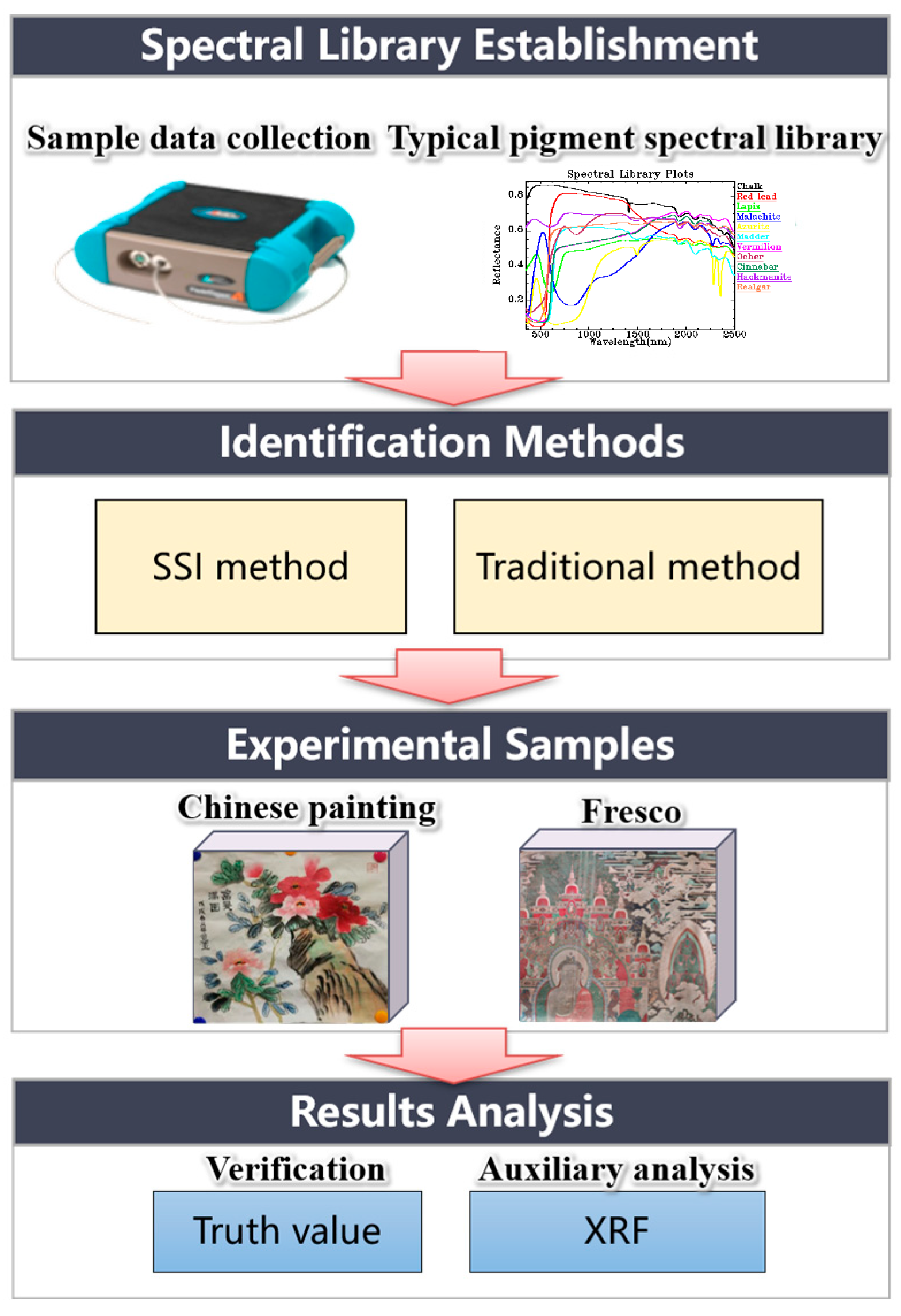

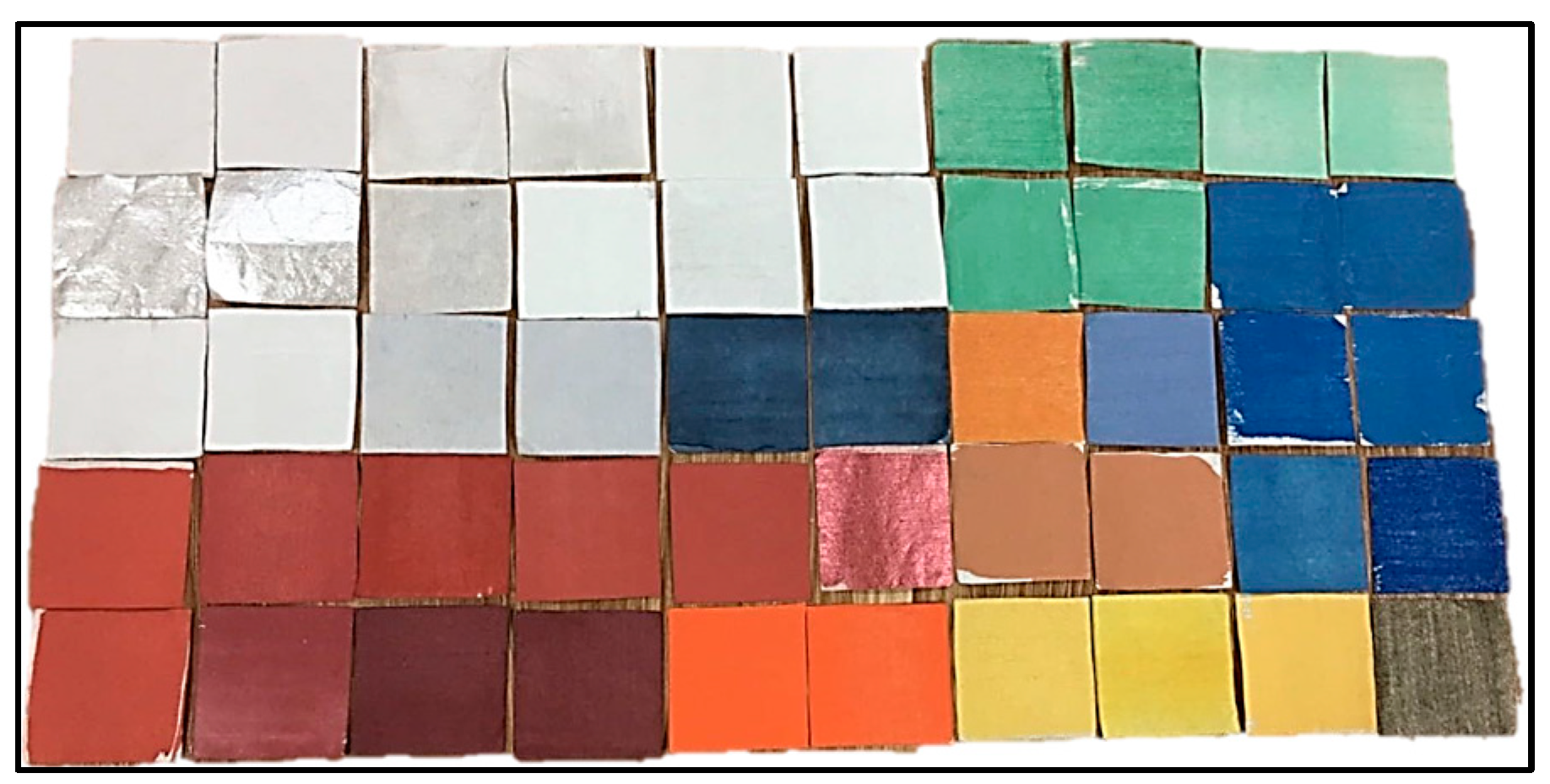
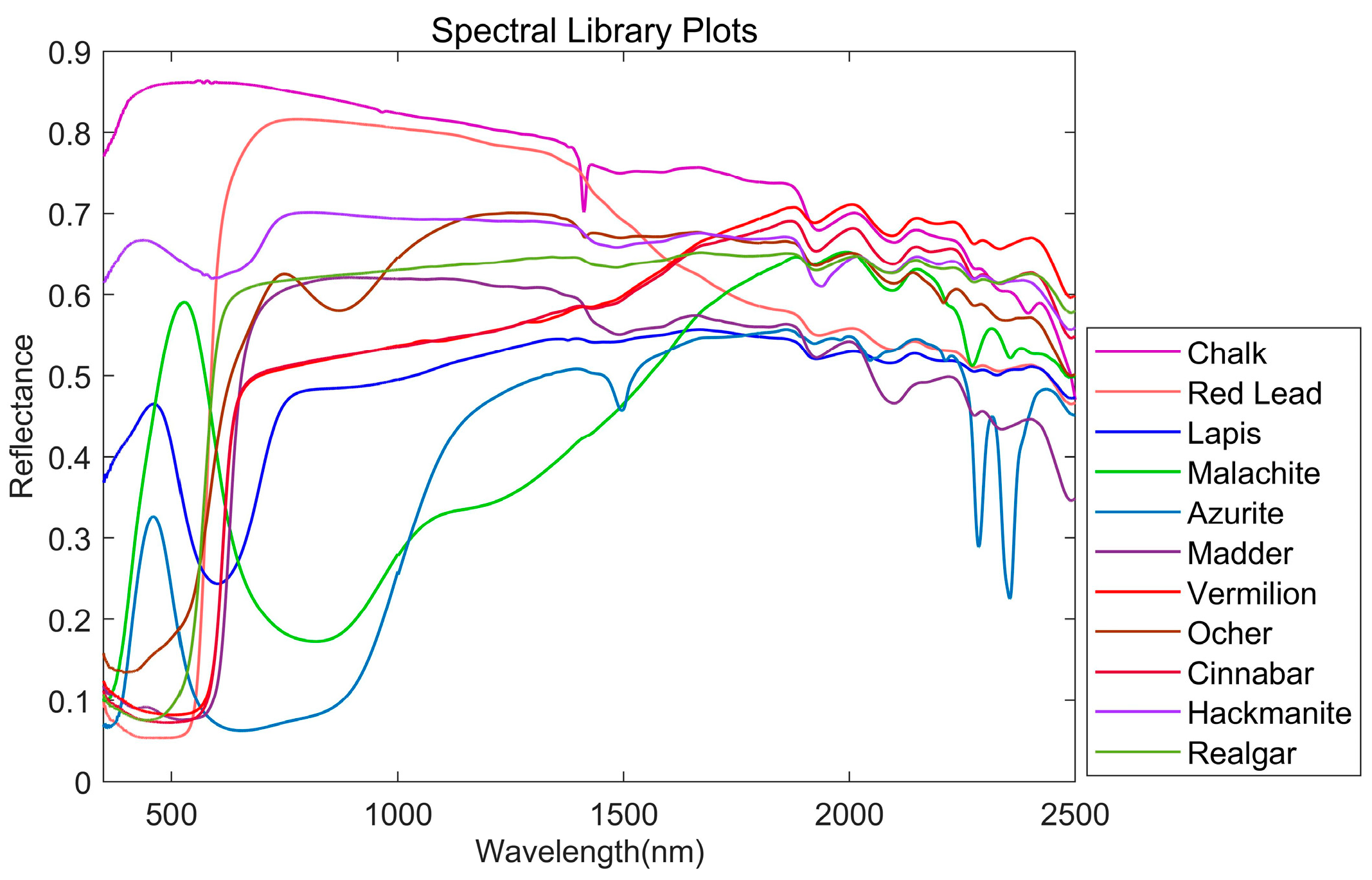
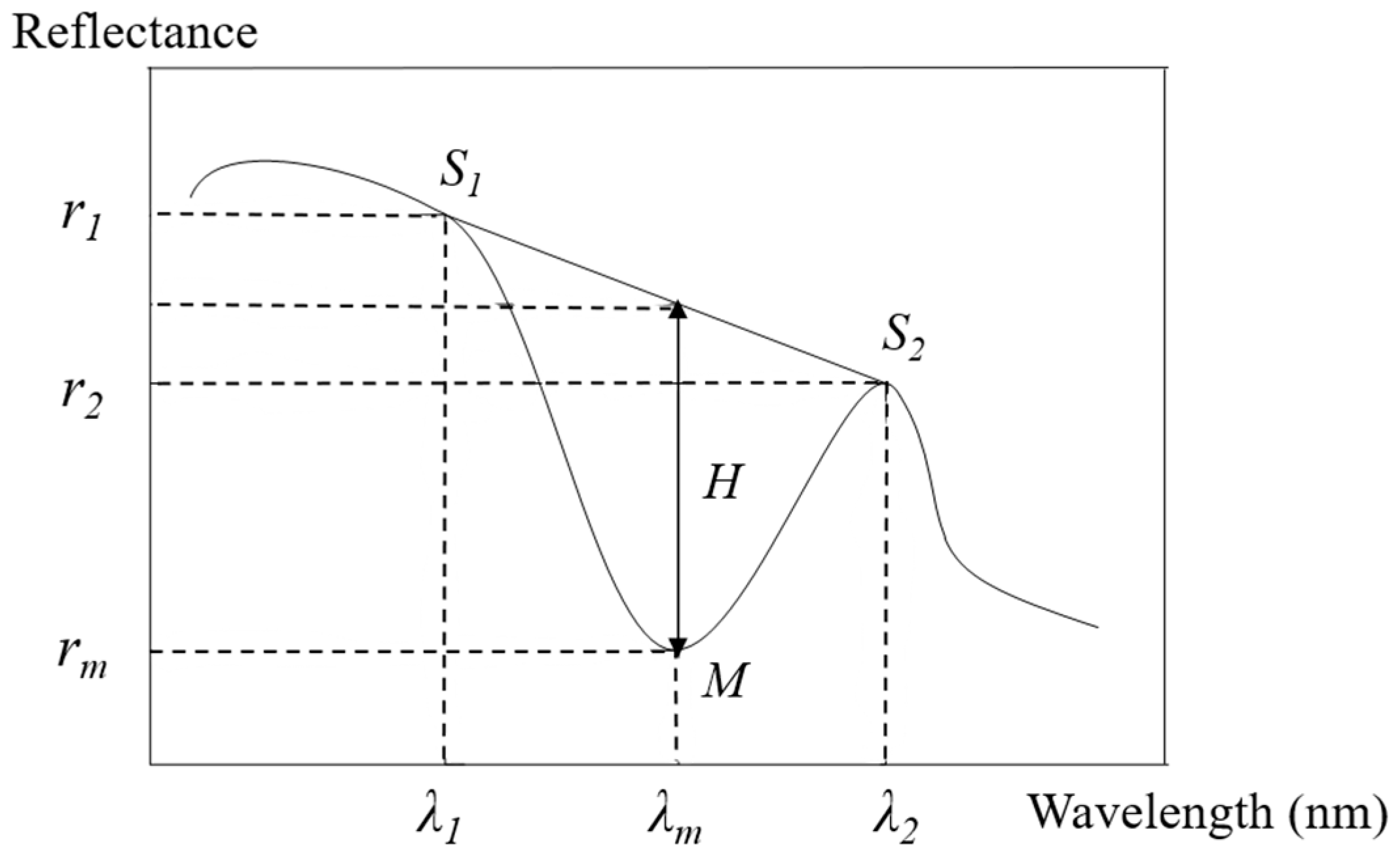
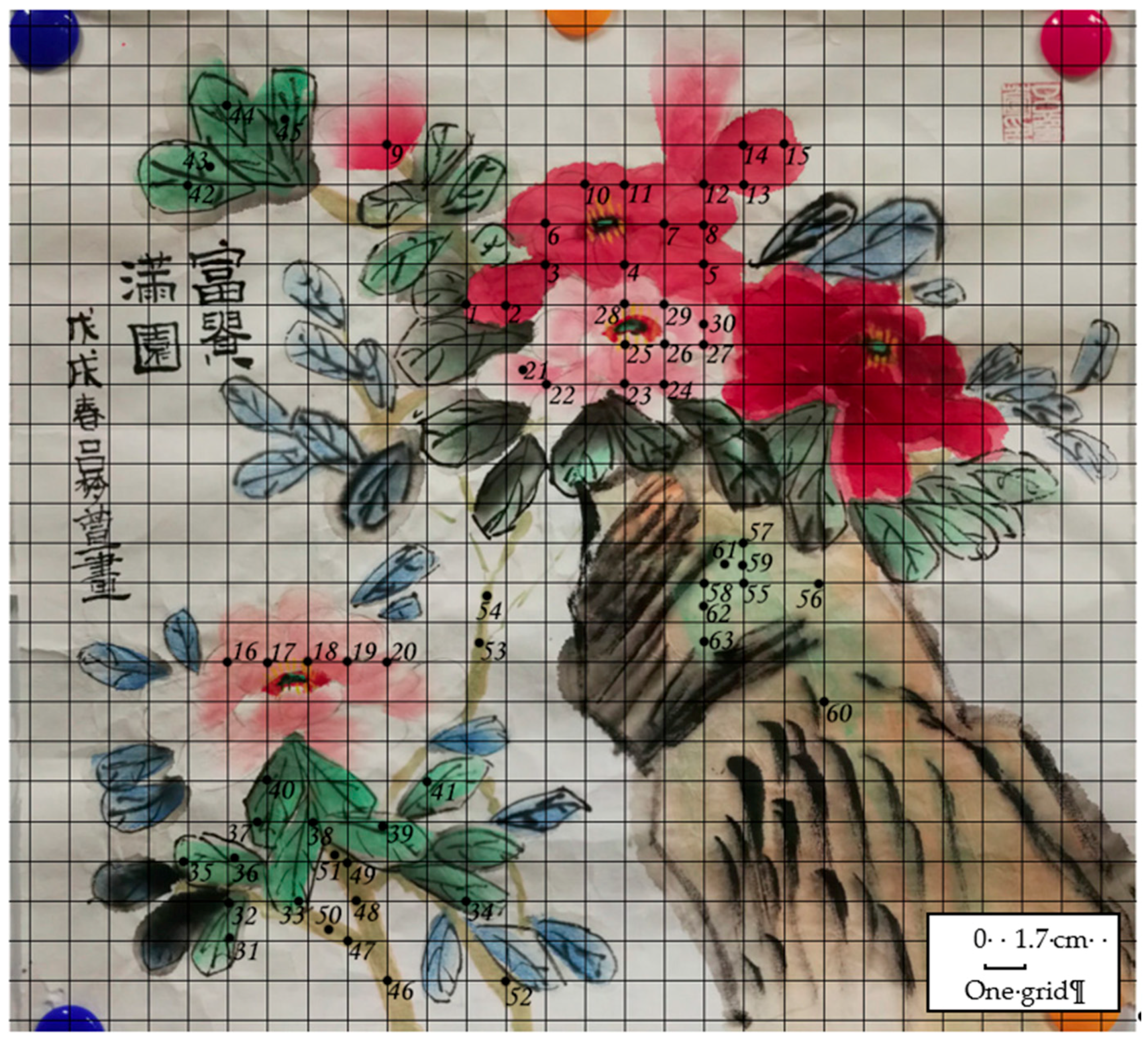
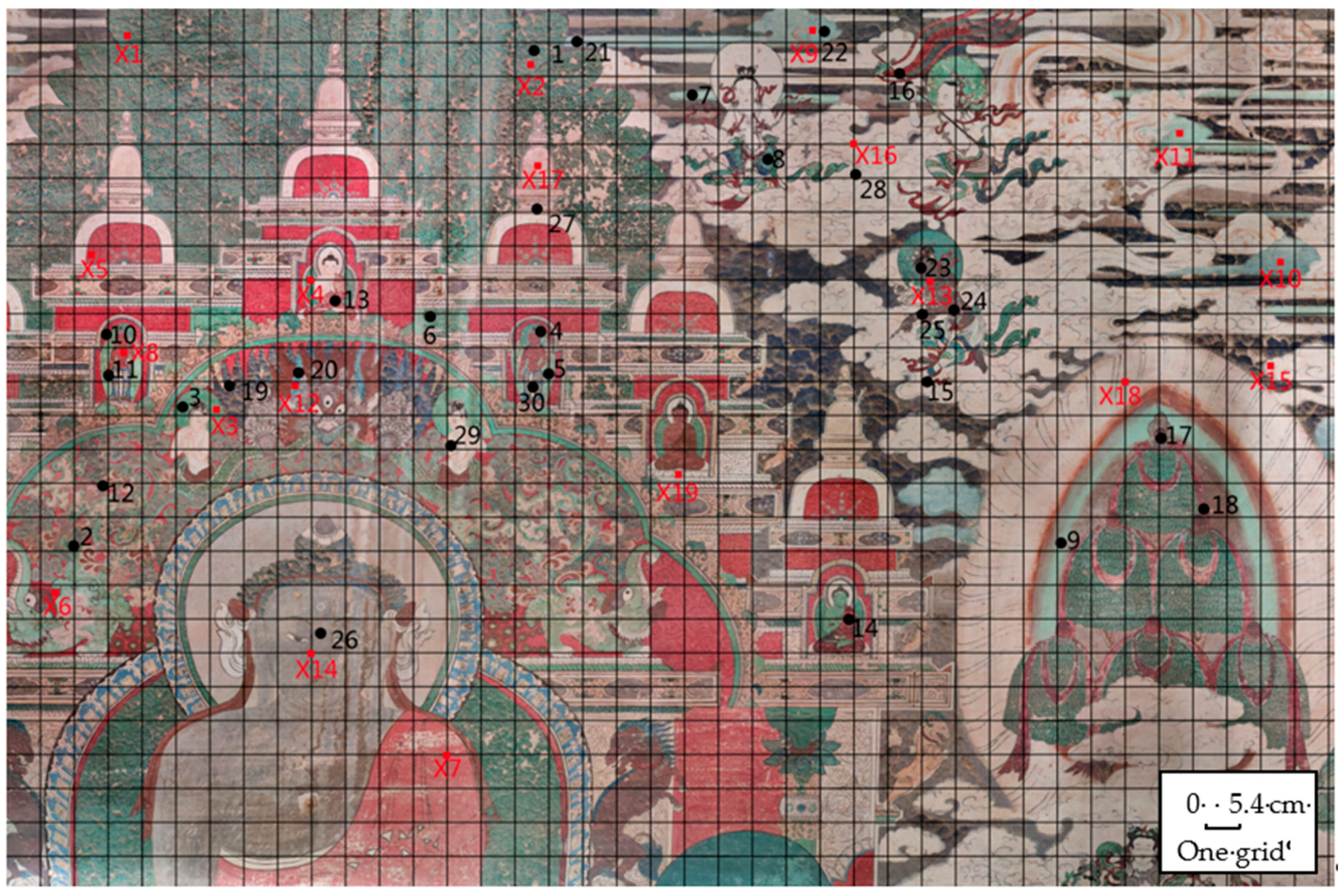
| Type | Tone | Pigment Name |
|---|---|---|
| Mineral pigments | Red | Cinnabar |
| Zinnober | ||
| Vermilion | ||
| Ocher | ||
| Yellow | Orpiment1 | |
| Realgar | ||
| Orpiment2 | ||
| Green | Malachite | |
| Malachite2 | ||
| Malachite3 | ||
| Blue | Azurite | |
| Azurite1 | ||
| Azurite2 | ||
| Azurite3 | ||
| Lapis | ||
| Hackmanite | ||
| White | Chalk | |
| Calcite | ||
| Muscovite | ||
| Clam meal | ||
| Lead white | ||
| Titanium white | ||
| Silver | ||
| Alum | ||
| Black | Biotite | |
| Botanical and chemical pigments | Red | Red lead |
| Crimson | ||
| Madder | ||
| Eosin | ||
| Yellow | Gamboge | |
| Blue | Cyanine | |
| White | Lead white | |
| Black | Ink |
| Name | Parameters |
|---|---|
| Spectral Range (Continuous Coverage) | 350–2500 nm |
| Spectral Bands | 2151 |
| Spectral Width | 2.5 nm |
| Spectral Resolution | 350–1000 nm @ 3 nm; 1001–2500 nm @ 8 nm |
| Size | 12.7 × 35.6 × 29.2 cm |
| Weight | 5.44 kg |
| Tone | Pigment Name | Main Component | Absorption Position of Metal Cation (μm) | Absorption Position of Function Group (μm) |
|---|---|---|---|---|
| Red | Cinnabar | HgS | Hg+: 0.6 | |
| Zinnober | HgS | |||
| Vermilion | HgS | |||
| Ocher | Fe2O3 | Fe3+: 0.9 | ||
| Yellow | Orpiment1 | As2S3 | 0.55 | |
| Realgar | As4S4 | |||
| Orpiment2 | As2S3 | |||
| Green | Malachite | CuCO3·Cu(OH)2 | Cu2+: 0.8, Strong decline before 0.52 | CO32−: 2.29,2.52 |
| Blue | Azurite | Cu3[CO3]2(OH)2 | Cu2+: 0.8, Strong decline before 0.52 | CO32−: 1.90,2.05,2.28; OH−: 1.45,1.95,2.35,2.50 |
| Lapis | (Na,Ca)4~8 (Al6Si6O24) (SO4,S)1~2 | Mixing of Na and other impurities: 0.6 | OH−: 1.40; H2O: 1.90; Envelope water: 2.50 | |
| Hackmanite | Na4(Al3Si3O12)Cl | Mixing of Na and other impurities: 0.6 | H2O: 1.90 | |
| White | Chalk | CaCO3 | ||
| Calcite | CaCO3 | CO32−: 1.88,2.00,2.16, (2.30)2.35,(2.50)2.55 | ||
| Muscovite | K2Al4(Si6Al2O20) (OH,F)4 | Fe2+: 0.44,0.9 | OH−:1.40; Al-O-H: 2.20,2.35,2.45 | |
| Clam meal | CaO | |||
| Titanium white | TiO2 | |||
| Silver | Al | |||
| Alum | KAl3(SO4)2(OH)6 | OH−: 1.01,1.35,1.45,1.78,2.00,2.17,2.33,2.50 | ||
| Black | Biotite | K(Mg,Fe)3AlSi3O10(F,OH)2 | OH−:1.40 |
| Regions | Typical Color | Name of Points | Number of Data | |
|---|---|---|---|---|
| C1 |  | 1–15 | 15 | |
| C2 |  | 16–30 | 15 | |
| C3 |  | 31–45 | 15 | |
| C4 |  | 46–54 | 9 | |
| C5 |  | 55–63 | 9 | |
| Name of Points | Results and Weights of Each Subsections (The Denominator is 9) | ||
|---|---|---|---|
| Subsection I | Subsection II | Subsection III | |
| 1 | Eosin3 Ocher2 Vermilion1 | Crimson3 Eosin2 Cyan1 | Madder3 Clam meal2 Eosin1 |
| 2 | Eosin3 Vermilion2 Madder1 | Crimson3 Cyan2 Eosin1 | Eosin3 Clam meal2 Madder1 |
| 3 | Eosin3 Ocher2 Vermilion1 | Crimson3 Eosin2 Cyan1 | Eosin3 Cyan2 Crimson1 |
| 4 | Eosin3 Vermilion2 Madder1 | Crimson3 Cyan2 Eosin1 | Madder3 Cyan2 Eosin1 |
| 5 | Eosin3 Vermilion2 Ocher1 | Crimson3 Cyan2 Eosin1 | Eosin3 Crimson2 Cyan1 |
| 6 | Eosin3 Ocher2 Vermilion1 | Crimson3 Eosin2 Cyan1 | Eosin3 Cyan2 Madder1 |
| 7 | Eosin3 Ocher2 Lapis1 | Crimson3 Eosin2 Cyan1 | Clam meal3 Eosin2 Madder1 |
| 8 | Eosin3 Vermilion2 Madder1 | Crimson3 Eosin2 Cyan1 | Eosin3 Cyan2 Madder1 |
| 9 | Eosin3 Vermilion2 Madder1 | Crimson3 Eosin2 Cyan1 | Madder3 Eosin2 Clam meal1 |
| 10 | Eosin3 Ocher2 Vermilion1 | Crimson3 Cyan2 Eosin1 | Eosin3 Cyan2 Madder1 |
| 11 | Eosin3 Ocher2 Lapis1 | Crimson3 Cyan2 Eosin1 | Eosin3 Cyan2 Madder1 |
| 12 | Eosin3 Vermilion2 Madder1 | Crimson3 Cyan2 Eosin1 | Eosin3 Madder2 Cyan1 |
| 13 | Eosin3 Vermilion2 Ocher1 | Crimson3 Eosin2 Cyan1 | Calcite3 Eosin2 Cyan1 |
| 14 | Eosin3 Vermilion2 Madder1 | Crimson3 Cyan2 Eosin1 | Eosin3 Calcite2 Cyan1 |
| 15 | Eosin3 Vermilion2 Ocher1 | Crimson3 Cyan2 Eosin1 | Eosin3 Cyan2 Madder1 |
| Weighted Index | Eosin: 0.778; Crimson: 0.356; Cyan: 0.304 | ||
| Regions | Thresholds |
|---|---|
| C1 | 0.35 |
| C2 | 0.26 |
| C3 | 0.32 |
| C4 | 0.27 |
| C5 | 0.37 |
| Regions | Results and Weighted Indices of SSI | Results of Traditional Method | Truth Value |
|---|---|---|---|
| C1 | Eosin 0.778 Crimson 0.356 Cyan 0.304 | Eosin Crimson Madder | Eosin Crimson Madder |
| C2 | Crimson 0.326 Ocher 0.259 Cyan 0.237 | Eosin Crimson Red lead | Crimson Clam meal |
| C3 | Malachite 0.778 Chalk 0.322 Ocher 0.289 | Malachite Ink Azurite | Malachite Ink |
| C4 | Ocher 0.728 Malachite 0.568 Clam meal 0.259 | Malachite Ink Vermilion | Ocher Malachite |
| C5 | Malachite 0.728 Ocher 0.619 Ink 0.247 | Malachite Ink Vermilion | Malachite Ocher |
| Regions | Typical Color | ASD | XRF | ||
|---|---|---|---|---|---|
| Points | Number of Data | Points | Number of Data | ||
| F1 |  | 1–9 | 9 | X1–X4 | 4 |
| F2 |  | 10–18 | 9 | X5–X8 | 4 |
| F3 |  | 19–22 | 4 | X9–X12 | 4 |
| F4 |  | 23–26 | 4 | X13–X14 | 2 |
| F5 |  | 27–30 | 4 | X15–X19 | 5 |
| Energy (kev) | Pb | Cu | S | Hg | Ca |
|---|---|---|---|---|---|
| X1 | 1562.01 | 278975.78 | 0.00 | 0.00 | 26503.66 |
| X2 | 1029.01 | 178149.56 | 0.00 | 0.00 | 32592.03 |
| X3 | 139.28 | 195848.00 | 0.00 | 0.00 | 44637.43 |
| X4 | 1252.71 | 164159.42 | 0.00 | 0.00 | 39282.22 |
| F1: Cu++, Ca+ | |||||
| X5 | 526.68 | 909.04 | 175032.56 | 69704.16 | 18542.46 |
| X6 | 2507.46 | 418.18 | 158248.25 | 106331.34 | 13908.16 |
| X7 | 2378.84 | 387.09 | 169500.92 | 107834.58 | 23325.84 |
| X8 | 26293.65 | 696.39 | 134419.11 | 17502.05 | 23500.73 |
| F2: S++, Hg+, Ca+ | |||||
| X9 | 40606.54 | 35573.78 | 136492.42 | 51.38 | 18149.19 |
| X10 | 56087.05 | 41295.69 | 166482.00 | 60.08 | 18344.49 |
| X11 | 123496.94 | 50570.20 | 265214.56 | 0.00 | 6308.32 |
| X12 | 6971.97 | 93195.71 | 67959.97 | 344.85 | 68024.49 |
| F3: S+, Cu+, Pb+ | |||||
| X13 | 48297.70 | 25055.33 | 208326.78 | 35.99 | 30534.81 |
| X14 | 31617.87 | 24609.80 | 176882.00 | 43.22 | 38761.93 |
| F4: S++, Pb+, Ca+, Cu+ | |||||
| X15 | 94247.71 | 414.08 | 188251.23 | 84.75 | 17509.94 |
| X16 | 93331.72 | 823.98 | 244973.98 | 145.86 | 14344.45 |
| X17 | 83581.70 | 556.53 | 160192.80 | 188.29 | 31010.53 |
| X18 | 30920.21 | 153.00 | 167193.38 | 44.93 | 41051.42 |
| X19 | 91778.10 | 683.97 | 216748.48 | 140.39 | 13162.02 |
| F5: S++, Pb+, Ca+ | |||||
| Name of Points | Pigments and Weights of Each Subsections (The Denominator is 12) | |||
|---|---|---|---|---|
| Subsection I | Subsection II | Subsection III | Subsection IV | |
| 1 | Malachite3 | Malachite3 | Malachite3 | Madder3 |
| Chalk2 | Ink2 | Vermilion2 | Eosin2 | |
| Clam meal1 | Ocher1 | Cinnabar1 | Cyan1 | |
| 2 | Orpiment13 | Malachite3 | Malachite3 | Malachite3 |
| Orpiment22 | Ink2 | Vermilion2 | Ocher2 | |
| Ink1 | Ocher1 | Cinnabar1 | Titanium white1 | |
| 3 | Malachite3 | Ocher3 | Malachite3 | Malachite3 |
| Chalk2 | Ink2 | Vermilion2 | Chalk2 | |
| Clam meal1 | Clam meal1 | Cinnabar1 | Ink1 | |
| 4 | Malachite3 | Malachite3 | Malachite3 | Malachite3 |
| Chalk2 | Ocher2 | Vermilion2 | Chalk2 | |
| Clam meal1 | Ink1 | Cinnabar1 | Ink1 | |
| 5 | Malachite3 | Ocher3 | Malachite3 | Chalk3 |
| Chalk2 | Ink2 | Vermilion2 | Malachite2 | |
| Clam meal1 | Clam meal1 | Cinnabar1 | Ink1 | |
| 6 | Malachite3 | Ocher3 | Malachite3 | Malachite3 |
| Chalk2 | Ink2 | Vermilion2 | Chalk2 | |
| Clam meal1 | Clam meal1 | Cinnabar1 | Ink1 | |
| 7 | Malachite3 | Ocher3 | Malachite3 | Chalk3 |
| Titanium white2 | Ink2 | Vermilion2 | Malachite2 | |
| Chalk1 | Malachite1 | Cinnabar1 | Ink1 | |
| 8 | Malachite3 | Malachite3 | Vermilion3 | Malachite3 |
| Chalk2 | Azurite2 | Cinnabar2 | Azurite2 | |
| Clam meal1 | Ink 1 | Gamboge1 | Calcite1 | |
| 9 | Ocher3 | Malachite3 | Malachite3 | Malachite3 |
| Orpiment22 | Ocher2 | Vermilion2 | Chalk2 | |
| Orpiment 11 | Ink1 | Cinnabar1 | Ink1 | |
| Weighted Index | Malachite: 0.769 | |||
| Chalk: 0.250 | ||||
| Ocher: 0.213 | ||||
| Ink: 0.194 | ||||
| Regions | Thresholds |
|---|---|
| F1 | 0.24 |
| F2 | 0.25 |
| F3 | 0.19 |
| F4 | 0.23 |
| F5 | 0.25 |
| Regions | Results and Weighted Indices of SSI | Results of Traditional Method | XRF Results |
|---|---|---|---|
| F1 | Malachite:0.769 CuCO3·Cu(OH)2 Chalk:0.250 CaCO3 | Malachite CuCO3·Cu(OH)2 Lapis (Na,Ca)4~8(Al6Si6O24)(SO4,S)1~2 Azurite Cu3[CO3]2(OH)2 | Cu++, Ca+ |
| F2 | Vermilion:0.346 HgS Chalk:0.321 CaCO3 Ocher:0.309 Fe2O3 | Ocher Fe2O3 Zinnober HgS Cinnabar HgS | S++, Hg+, Ca+ |
| F3 | Malachite:0.380 CuCO3·Cu(OH)2 Azurite:0.310 Cu3[CO3]2(OH)2 | Azurite Cu3[CO3]2(OH)2 Lapis (Na,Ca)4~8 (Al6Si6O24) (SO4,S)1~2 Cyan | S+, Cu+, Pb+ |
| F4 | Cinnabar:0.400 HgS Zinnober:0.310HgS Clam meal:0.250 CaO Lead white:0.250 2PbCO3·Pb(OH)2 Vermilion:0.250 HgS | Hackmanite Na4(Al3Si3O12)Cl Orpiment 2 As2S3 Ocher Fe2O3 | S++, Pb+, Ca+, Cu+ |
| F5 | Chalk:0.440 CaCO3 Lead white:0.220 2PbCO3·Pb(OH)2 | Chalk CaCO3 Lead white 2PbCO3·Pb(OH)2 Clam mealCaO | S++, Pb+, Ca+ |
| Number | Color of Samples | Pigments |
|---|---|---|
| 1 | Green | Malachite, Atacamite, Eriochalcite |
| 2 | Red | Cinnabar, Red lead |
| 3 | Light red | Lead oxide |
| 4 | Blue | Azurite |
| 5 | Light blue | Lapis |
| 6 | Black | Lead white |
| 7 | Light yellow | Gypsum, Lead white |
| 8 | Brown | Lead dioxide |
| 9 | White | Lead white, Calcite |
| Method | C1 | C2 | C3 | C4 | C5 | (Average) Accuracy | |
| Top 1 | SSI method | √ | √ | √ | √ | √ | 100.0% |
| Traditional method | √ | × | √ | √ | √ | 80.0% | |
| Top 3 | SSI method | 67% | 50% | 50% | 100% | 100% | 73.4% |
| Traditional method | 100% | 50% | 100% | 50% | 50% | 70.0% | |
| Method | F1 | F2 | F3 | F4 | F5 | (Average) Accuracy | |
| Top 1 | SSI method | √ | √ | √ | √ | √ | 100.0% |
| Traditional method | √ | × | √ | × | √ | 60.0% | |
| Top 3 | SSI method | 100% | 100% | 33% | 75% | 67% | 75.0% |
| Traditional method | 100% | 67% | 33% | 25% | 67% | 58.4% |
Publisher’s Note: MDPI stays neutral with regard to jurisdictional claims in published maps and institutional affiliations. |
© 2020 by the authors. Licensee MDPI, Basel, Switzerland. This article is an open access article distributed under the terms and conditions of the Creative Commons Attribution (CC BY) license (http://creativecommons.org/licenses/by/4.0/).
Share and Cite
Liu, Y.; Lyu, S.; Hou, M.; Gao, Z.; Wang, W.; Zhou, X. A Novel Spectral Matching Approach for Pigment: Spectral Subsection Identification Considering Ion Absorption Characteristics. Remote Sens. 2020, 12, 3415. https://doi.org/10.3390/rs12203415
Liu Y, Lyu S, Hou M, Gao Z, Wang W, Zhou X. A Novel Spectral Matching Approach for Pigment: Spectral Subsection Identification Considering Ion Absorption Characteristics. Remote Sensing. 2020; 12(20):3415. https://doi.org/10.3390/rs12203415
Chicago/Turabian StyleLiu, Yiyi, Shuqiang Lyu, Miaole Hou, Zhenhua Gao, Wanfu Wang, and Xiao Zhou. 2020. "A Novel Spectral Matching Approach for Pigment: Spectral Subsection Identification Considering Ion Absorption Characteristics" Remote Sensing 12, no. 20: 3415. https://doi.org/10.3390/rs12203415
APA StyleLiu, Y., Lyu, S., Hou, M., Gao, Z., Wang, W., & Zhou, X. (2020). A Novel Spectral Matching Approach for Pigment: Spectral Subsection Identification Considering Ion Absorption Characteristics. Remote Sensing, 12(20), 3415. https://doi.org/10.3390/rs12203415




